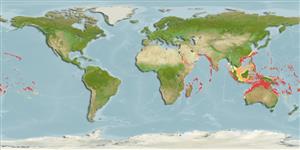>
Acanthuriformes (Surgeonfishes) >
Chaetodontidae (Butterflyfishes)
Etymology: Forcipiger: Latin, forceps = instrument of the pincers kind used for seizing and holding objects, esp. In surgical and obstetric operations + latin, gero = to carry; 1634 (Ref. 45335).
Issue
The species Forcipiger cyrano Randall, 1961 is considered as valid in Eschmeyer (CofF ver. Mar. 2011: Ref. 86697) following Randall (2007: Ref. 86689).
Environment: milieu / climate zone / depth range / distribution range
Ecología
marino asociado a arrecife; no migratorio; rango de profundidad 0 - 200 m (Ref. 89972). Tropical; 28°N - 28°S, 32°E - 130°W
Indo-Pacific: East Africa to the Hawaiian, Marquesan, and Pitcairn islands, north to the Bonin [=Ogasawara] Islands, south to New Caledonia and the Austral Islands; throughout Micronesia.
Tamaño / Peso / Age
Maturity: Lm ? range ? - ? cm
Max length : 22.0 cm TL macho / no sexado; (Ref. 9710)
Espinas dorsales (total) : 10 - 11; Radios blandos dorsales (total) : 24 - 28; Espinas anales: 3; Radios blandos anales: 17 - 20.
A generally uncommon species that inhabits seaward reefs to depths greater than 60 m (Ref. 9710). Benthopelagic (Ref. 58302). Feeds mainly on whole organisms such as small crustaceans. Usually seen in pairs. Oviparous (Ref. 205), monogamous (Ref. 52884). Forms pairs during breeding (Ref. 205). Sometimes dark brown instead of yellow (Ref. 48636). In the East Indian region this species is replaced by F. wanai at Cenderawasih Bay (Ref. 90102). Minimum depth reported taken from Ref. 128797.
Life cycle and mating behavior
Maturities | Reproducción | Spawnings | Egg(s) | Fecundities | Larva
Distinct pairing (Ref. 205). Monogamous mating is observed as both obligate and social (Ref. 52884).
Myers, R.F., 1991. Micronesian reef fishes. Second Ed. Coral Graphics, Barrigada, Guam. 298 p. (Ref. 1602)
IUCN Red List Status (Ref. 130435)
Threat to humans
Harmless
Human uses
Pesquerías: escaso valor comercial; Acuario: Comercial
Herramientas
Special reports
Download XML
Fuentes de Internet
Estimates based on models
Preferred temperature (Ref.
123201): 24.7 - 29, mean 27.9 °C (based on 992 cells).
Phylogenetic diversity index (Ref.
82804): PD
50 = 0.6250 [Uniqueness, from 0.5 = low to 2.0 = high].
Bayesian length-weight: a=0.02291 (0.01212 - 0.04329), b=3.02 (2.86 - 3.18), in cm total length, based on LWR estimates for this species & (Sub)family-body (Ref.
93245).
Nivel trófico (Ref.
69278): 3.5 ±0.50 se; based on food items.
Resiliencia (Ref.
120179): Alto, población duplicada en un tiempo mínimo inferior a 15 meses (Preliminary K or Fecundity.).
Fishing Vulnerability (Ref.
59153): Low vulnerability (12 of 100).
Nutrients (Ref.
124155): Calcium = 73 [37, 118] mg/100g; Iron = 0.713 [0.418, 1.163] mg/100g; Protein = 18.7 [17.5, 19.8] %; Omega3 = 0.141 [0.084, 0.234] g/100g; Selenium = 45.9 [25.1, 84.4] μg/100g; VitaminA = 47.7 [13.6, 165.1] μg/100g; Zinc = 1.14 [0.78, 1.63] mg/100g (wet weight);
